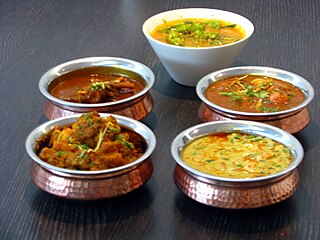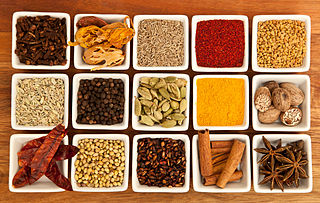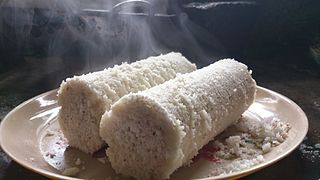
Curry is a variety of dishes originating in the Indian subcontinent that use a complex combination of spices or herbs, usually including ground turmeric, cumin, coriander, ginger, and fresh or dried chilies. In southern India, where the word originated, curry leaves, from the curry tree, are also an integral ingredient. Turmeric is known as the main spice in curry, which has a warm, bitter taste and is frequently used to flavor or color curry powders, mustards, butters, and cheeses. Curry is generally prepared in a sauce.

Pala is a town and a municipality in Kerala, India. It is located 28 km east of the district capital Kottayam and is situated 173 km north of the state capital Thiruvananthapuram. It is situated in the banks of Meenachil river. It spans over an area of 74.09 square kilometres (28.61 sq mi) and is the headquarters of the Meenachil Taluk and the Pala Revenue Division.

Indian cuisine consists of a variety of regional and traditional cuisines native to the Indian subcontinent. Given the diversity in soil, climate, culture, ethnic groups, and occupations, these cuisines vary substantially and use locally available spices, herbs, vegetables, and fruits. Indian food is also heavily influenced by religion, in particular Hinduism, cultural choices and traditions. Centuries of Islamic rule, particularly by the Mughals, also introduced dishes like samosa and pilaf.
Jamaican cuisine includes a mixture of cooking techniques, flavours and spices influenced by Amerindian, African, Irish, English, French, Portuguese, Spanish, Indian, Chinese and Middle Eastern people who have inhabited the island. It is also influenced by the crops introduced into the island from tropical Southeast Asia. All of which are now grown locally in Jamaica. A wide variety of seafood, tropical fruits and meats are available.

Biryani is a mixed rice dish originating among the Muslims of the Indian subcontinent. It is made with Indian spices, rice, and meat, and sometimes, in addition, eggs and/or vegetables such as potatoes in certain regional varieties. Biryani is popular throughout the Indian subcontinent, as well as among its diaspora. It is also prepared in other regions such as parts of Afghanistan, Pakistan, Iran, and Iraq.

Tamil cuisine is a culinary style originating in the southern Indian state Tamil Nadu and other parts of South Asia such as Sri Lanka. Vegetarian cuisine is popular among the Tamil people and has been so since ancient times. However, meats along with rice, legumes and lentils are also popular. Dairy products and tamarind are used to provide sour flavors. On special occasions, traditional Tamil dishes are served in a traditional manner, using banana leaves in place of utensils. After eating, the banana leaves are then used as a secondary food for cattle. A typical breakfast meal consists of idli or dosa with chutney. Lunch includes rice, sambar, curd, kuzhambu, and rasam.

Cuisine of the Indian subcontinent includes the cuisines from the Indian subcontinent comprising the traditional cuisines from Bangladesh, Bhutan, India, the Maldives, Nepal, Pakistan and Sri Lanka.

Idiyappam, also known as string hopper, nool puttu, or noolappam, chomai, indiappa is a rice noodle dish originating from the Indian states of Tamil Nadu and Kerala. Also in Srilanka. It consists of rice flour pressed into noodles, woven into a flat disc-like shape and steamed. The dish also spread to Southeast Asia, where it is called putu mayam in Malaysia and Singapore, putu mayang in Indonesia.

Puttu is a breakfast dish eaten in the South Indian states of Kerala, Tamil Nadu and parts of Karnataka, as well as Sri Lanka. Puttu means "portioned" in Malayalam. It is made of steamed cylinders of ground rice layered with coconut shavings, sometimes with a sweet or savory filling on the inside. Puttu is served hot with sweet side dishes such as palm sugar or banana, or with curries such as dal, chickpea, mutton, fish or chicken. In Bhatkal, puttu is served with side dishes such as ghee and sugar or Paya.

Appam is a South Indian pancake dish, made with fermented rice batter and coconut milk, common in the South Indian states of Kerala, Karnataka and Tamil Nadu as well as in Sri Lanka. It can be made and served in both sweet and savoury varieties, with the centre of the appam having either a creamy, coconut milk layer or a sunnyside up-style fried egg. Appam is usually served for breakfast or dinner.

South Indian cuisine includes the cuisines of the five southern states of India—Andhra Pradesh, Karnataka, Kerala, Tamil Nadu and Telangana—and the union territories of Lakshadweep, Pondicherry, and the Andaman and Nicobar Islands.There are typically vegetarian and non-vegetarian dishes for all five states. Additionally, all regions have typical main dishes, snacks, light meals, desserts, and drinks that are well known in their respective region.

Goan cuisine consists of regional foods popular in Goa, an Indian state located along India's west coast on the shore of the Arabian Sea. Rice, seafood, coconut, vegetables, meat, pork and local spices are some of the main ingredients in Goan cuisine. The area is located in a tropical climate, which means that spices and flavors are intense. Use of kokum is another distinct feature. Goan food is considered incomplete without fish.

Javanese cuisine is the cuisine of Javanese people, a major ethnic group in Indonesia, more precisely the province of Central Java, Yogyakarta and East Java. Though the cuisine of Sumatra is known for its spiciness with notable Indian and Arabic influences, Javanese cuisine is more indigenously developed and noted for its simplicity. Some of Javanese dishes demonstrate foreign influences, most notably Chinese.

Telugu cuisine is a cuisine of South India native to the Telugu people from the states of Andhra Pradesh and Telangana. Generally known for its tangy, hot and spicy taste, the cooking is very diverse due to the vast spread of the people and varied topological regions.

Malaysian Indian cuisine, or the cooking of the ethnic Indian communities in Malaysia consists of adaptations of authentic dishes from India, as well as original creations inspired by the diverse food culture of Malaysia. Because the vast majority of Malaysia's Indian community are of South Indian descent, and are mostly ethnic Tamils who are descendants of immigrants from a historical region which consists of the modern Indian state of Tamil Nadu and Sri Lanka's Northern Province, much of Malaysian Indian cuisine is predominantly South Indian inspired in character and taste. A typical Malaysian Indian dish is likely to be redolent with curry leaves, whole and powdered spice, and contains fresh coconut in various forms. Ghee is still widely used for cooking, although vegetable oils and refined palm oils are now commonplace in home kitchens. Before a meal it is customary to wash hands as cutlery is often not used while eating, with the exception of a serving spoon for each respective dish.

Thalassery Cuisine refers to the distinct cuisine from Thalassery town of northern Kerala, that has blended in Arabian, Persian, Indian and European styles of cooking as a result of its long history as a maritime trading post. Thalassery is known for its Tellicherry biriani. Unlike other biriyani dishes Thalassery biryani that is made using Kaima/ Jeerakasala, an Indian aromatic rice instead of the usual basmati rice. The influence of Arabian and Moghul cultures is evident, especially in the dishes of the Muslim community, although many have become popular among all communities.

Street food, as in other areas of India, are popular in Chennai, despite the common belief in India that street food is unhealthy. The Idly Sambhar is a popular dish, which is served as breakfast or dinner. Apart from regular South Indian street food, the city's streets are also filled with several North Indian street food outlets, most of them established by North Indian migrants themselves. Gujarati and Burmese are also available. Street food in Chennai is so popular that a game had developed based on the TV show The Amazing Race where contestants have to follow clues to Street-food spots in the city.

Acehnese cuisine is the cuisine of the Acehnese people of Aceh in Sumatra, Indonesia. This cuisine is popular and widely known in Indonesia. Arab, Persian, and Indian traders influenced food in Aceh although flavours have changed a lot their original forms. Combination of spices in Acehnese cuisine just as are commonly found in Indian and Arab cuisine, such as ginger, pepper, coriander, cumin, cloves, cinnamon, cardamom and fennel. A variety of Acehnese food is cooked with curry and/or coconut milk, which is generally combined with meat such as buffalo, beef, mutton, fish, or chicken.

Indian Indonesian cuisine is characterized by the mixture of Indian cuisine with local Indonesian-style. This cuisine consists of adaptations of authentic dishes from India, as well as original creations inspired by the diverse food culture of Indonesia. Indian influence can be observed in Indonesia as early as the 4th century. Following the spread of Islam to Indonesia and trading, Muslim Indian as well as Arab influences made their way into Indonesian cuisine. Examples include Indian biryani, murtabak, curry and paratha that influenced Acehnese, Minangkabau, Malay, Palembangese, Betawi and Javanese cuisine.




















